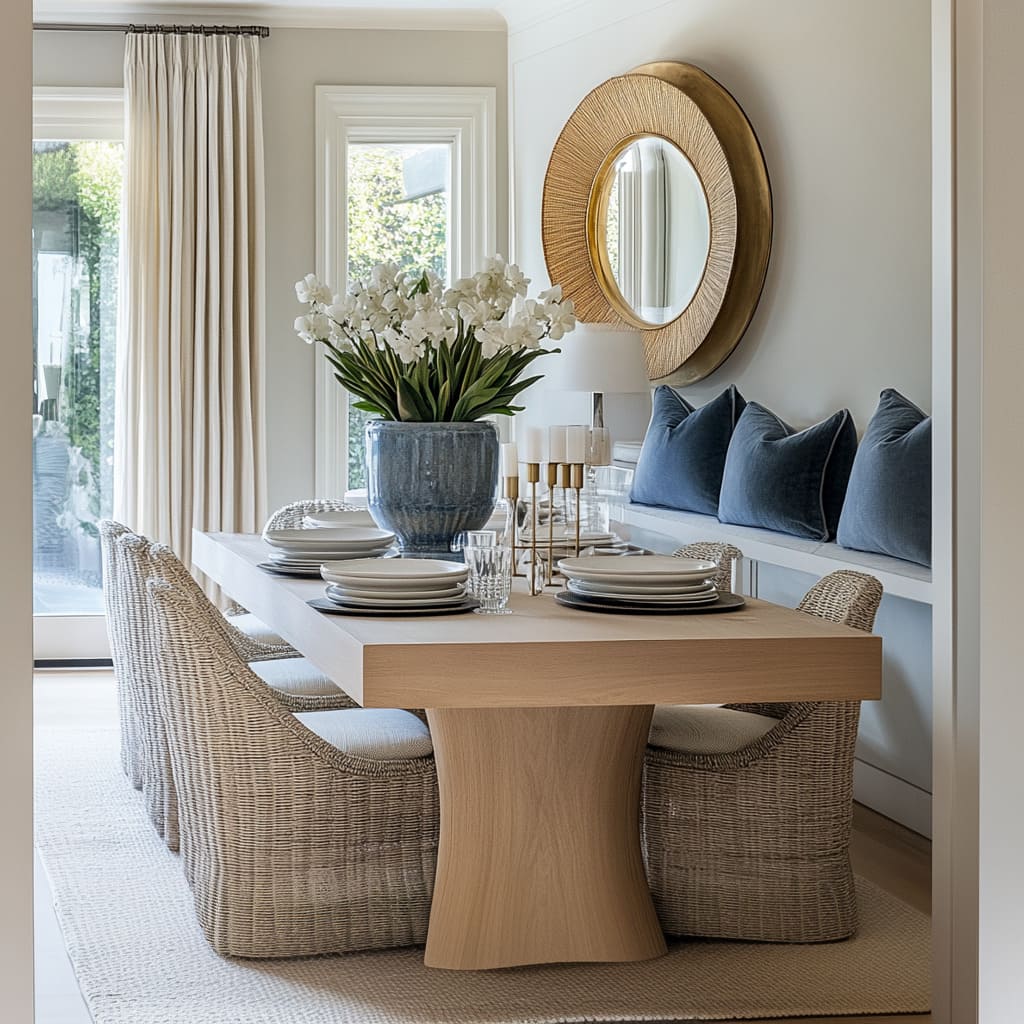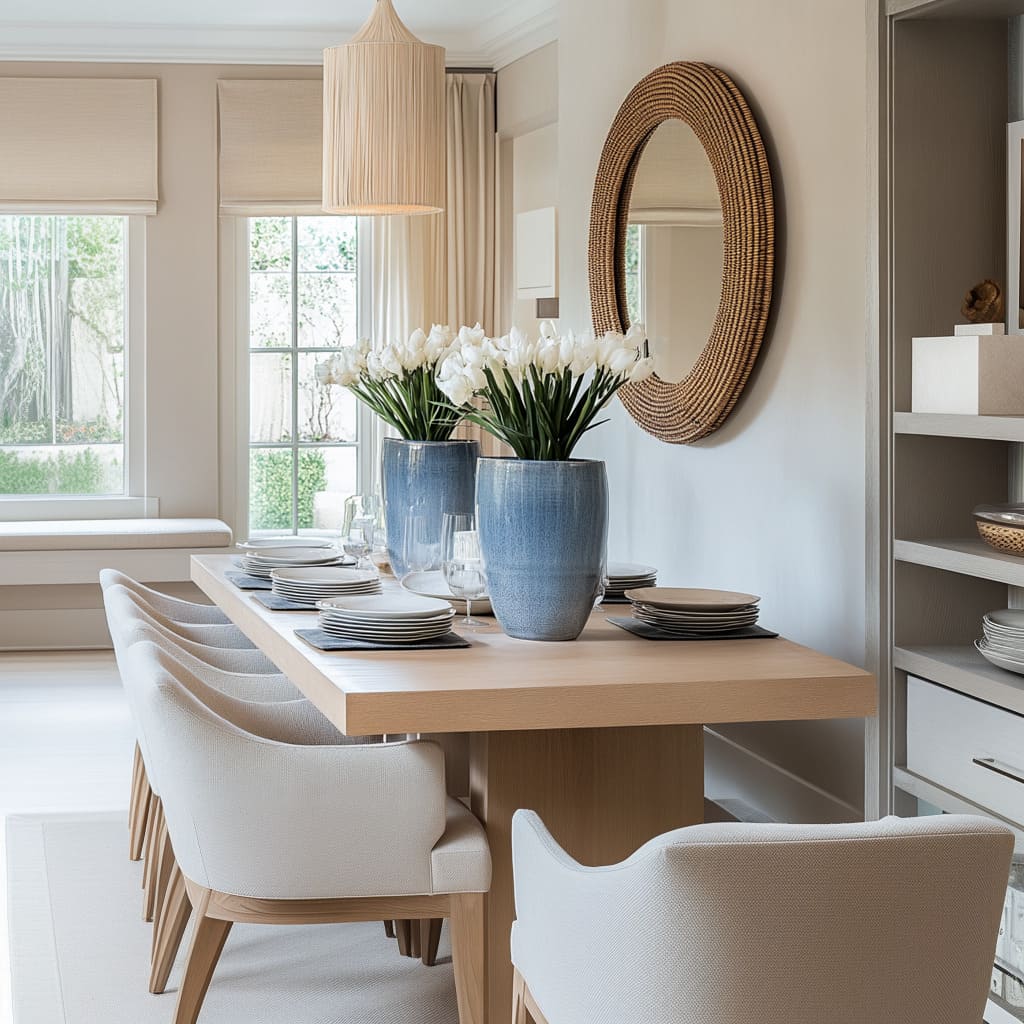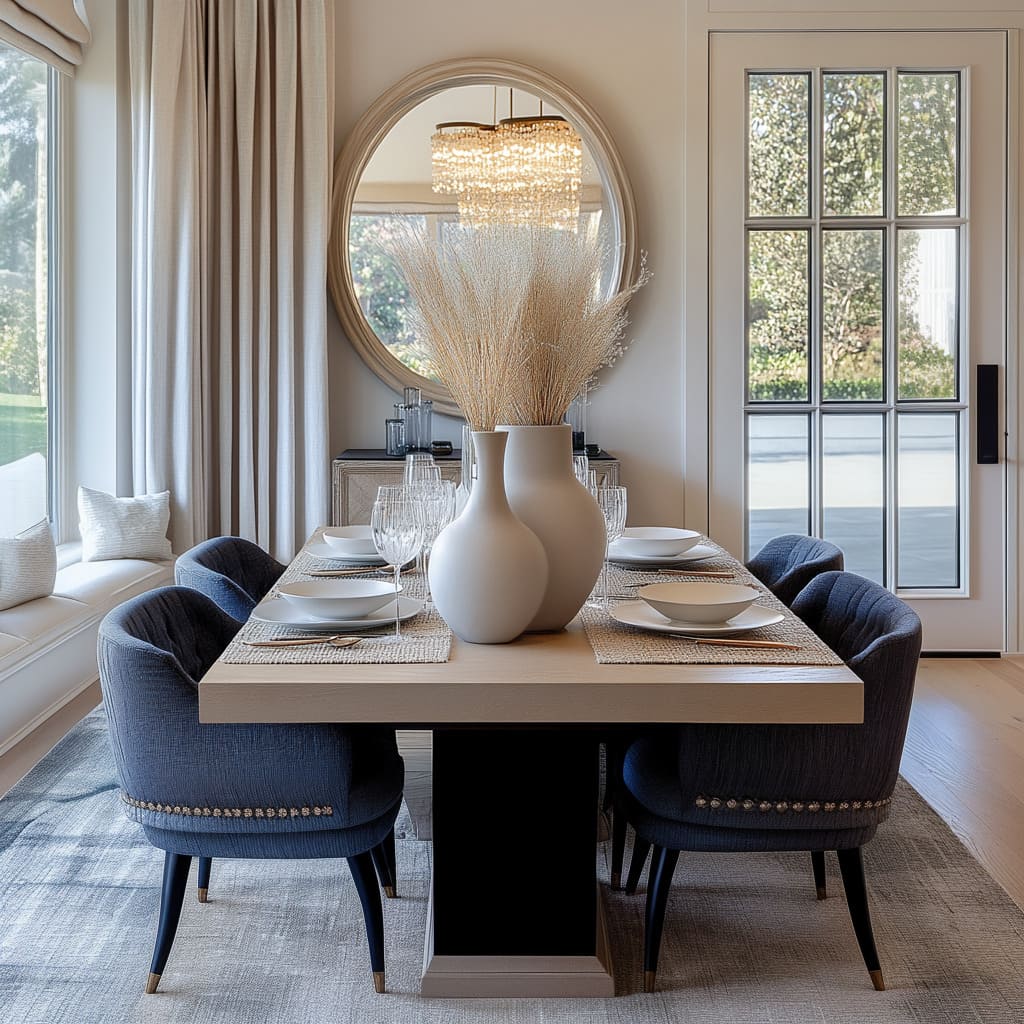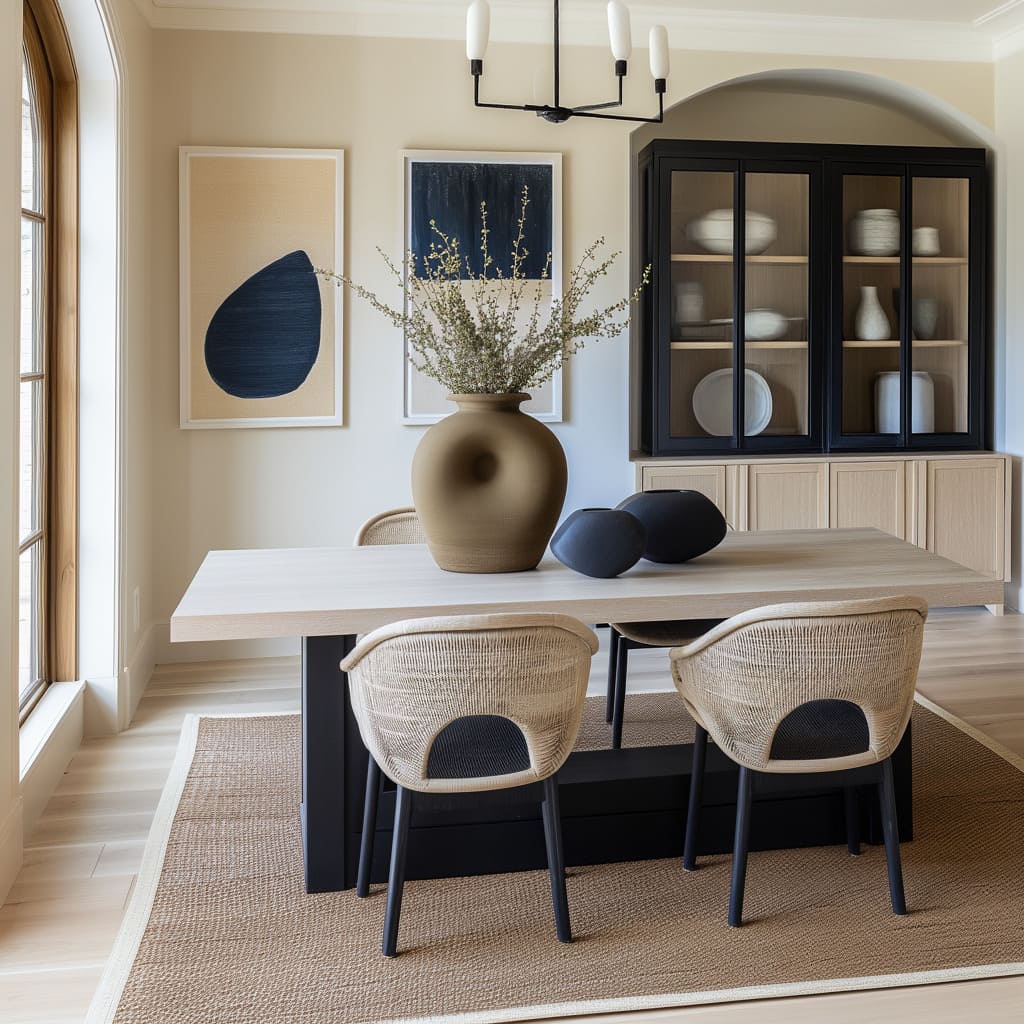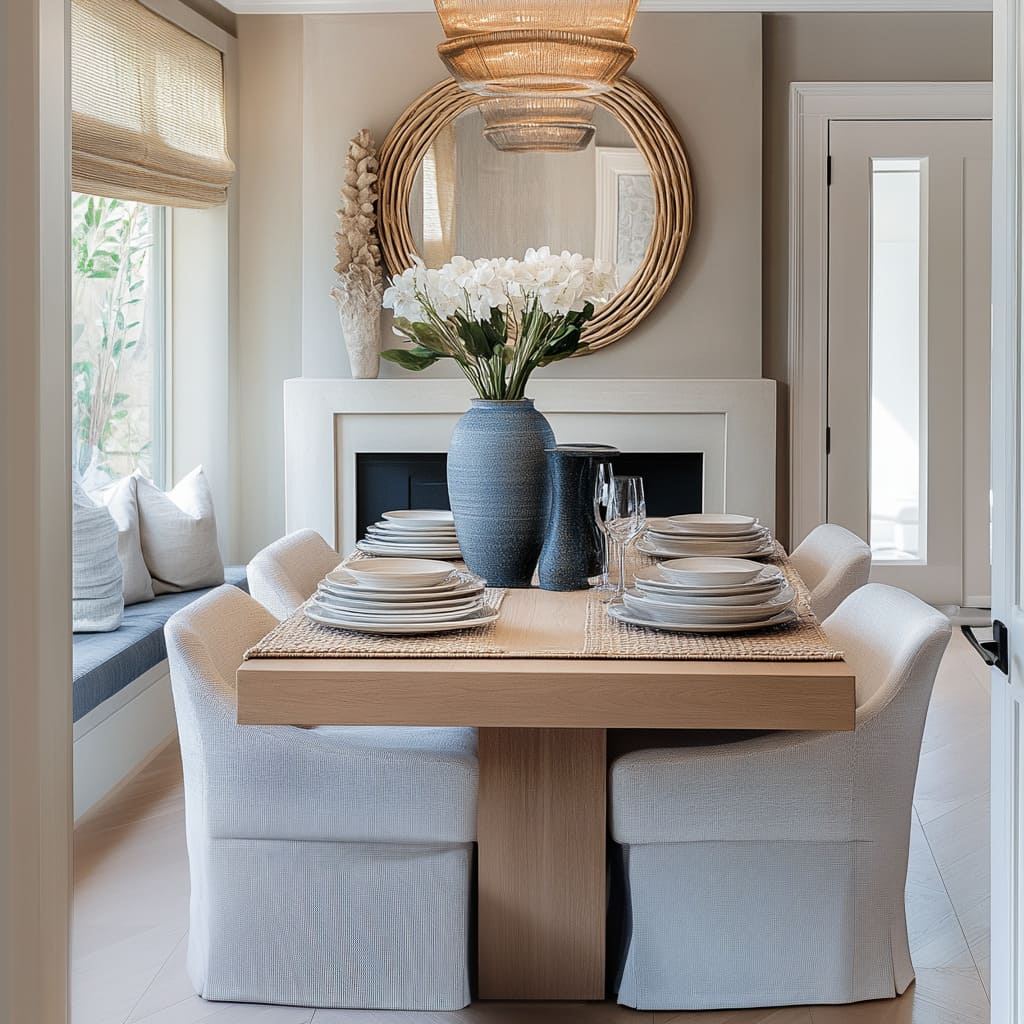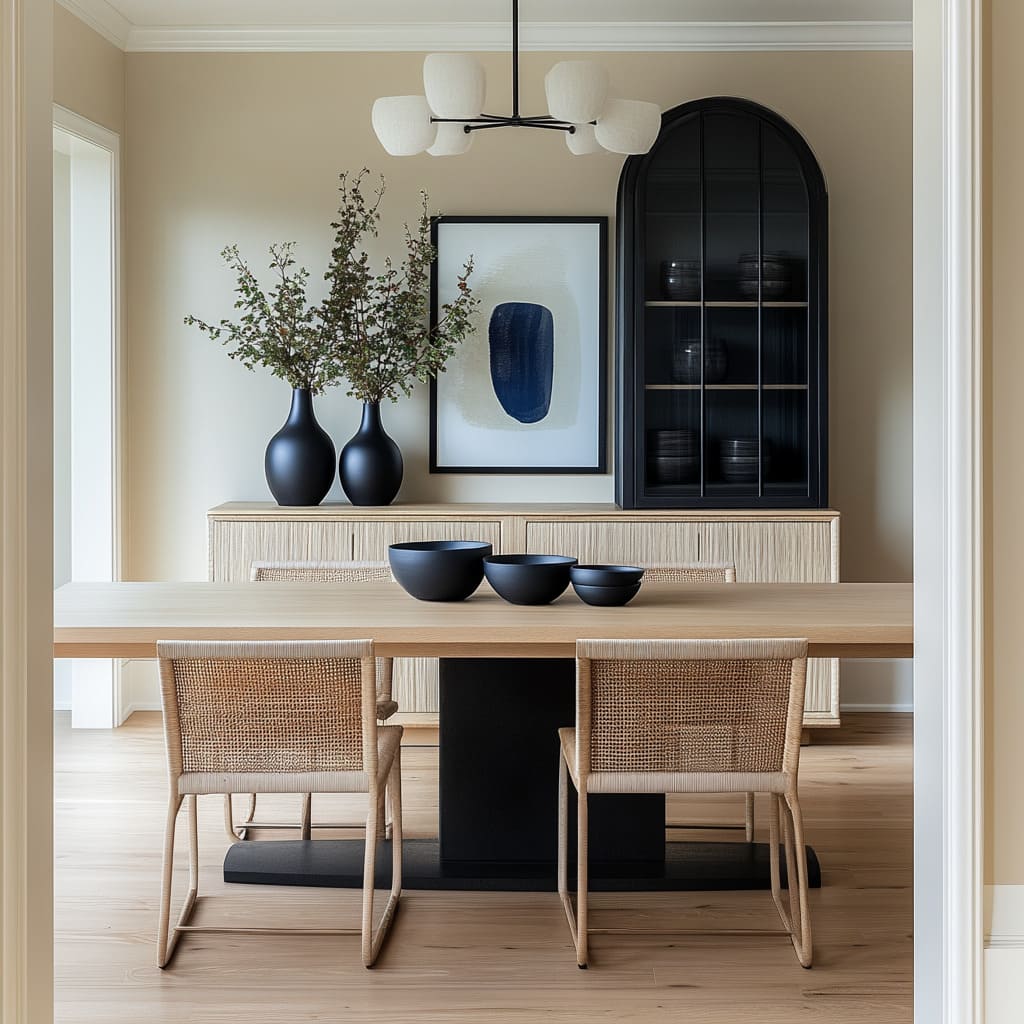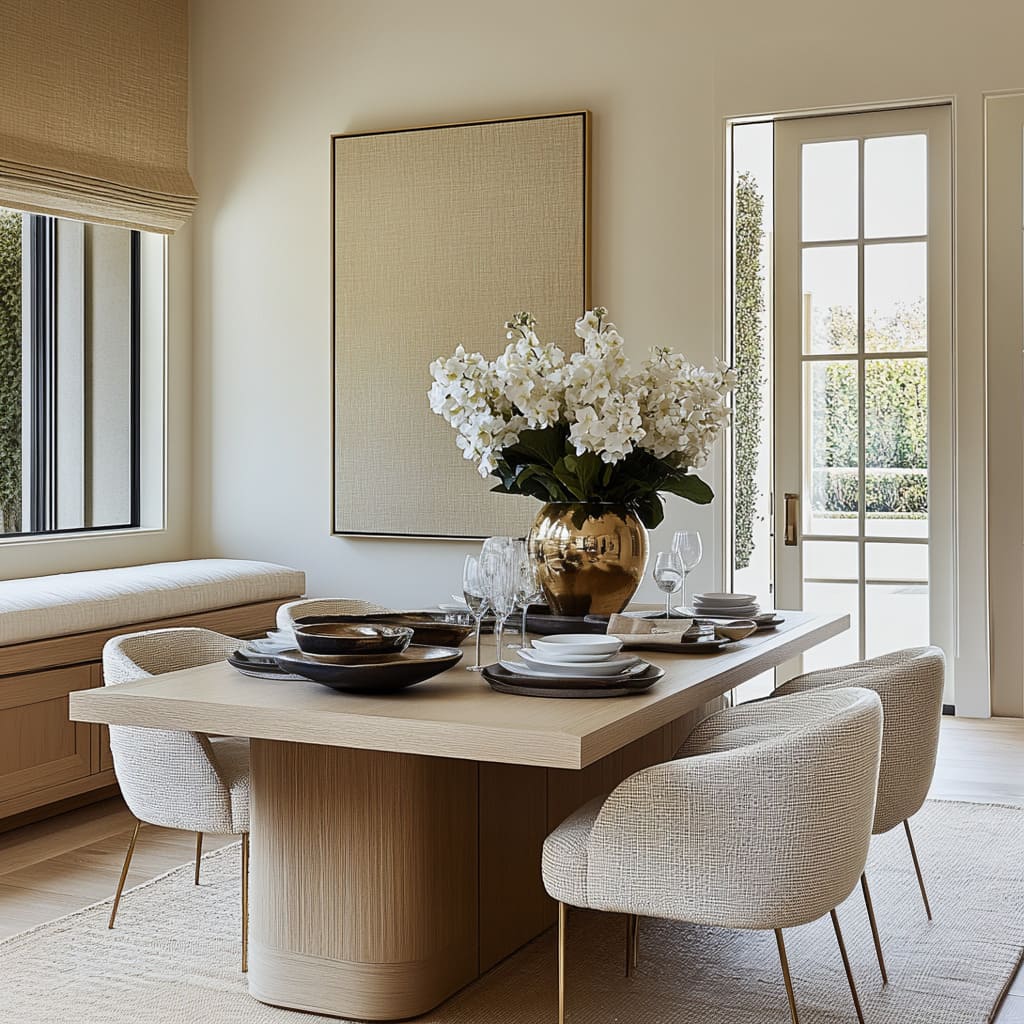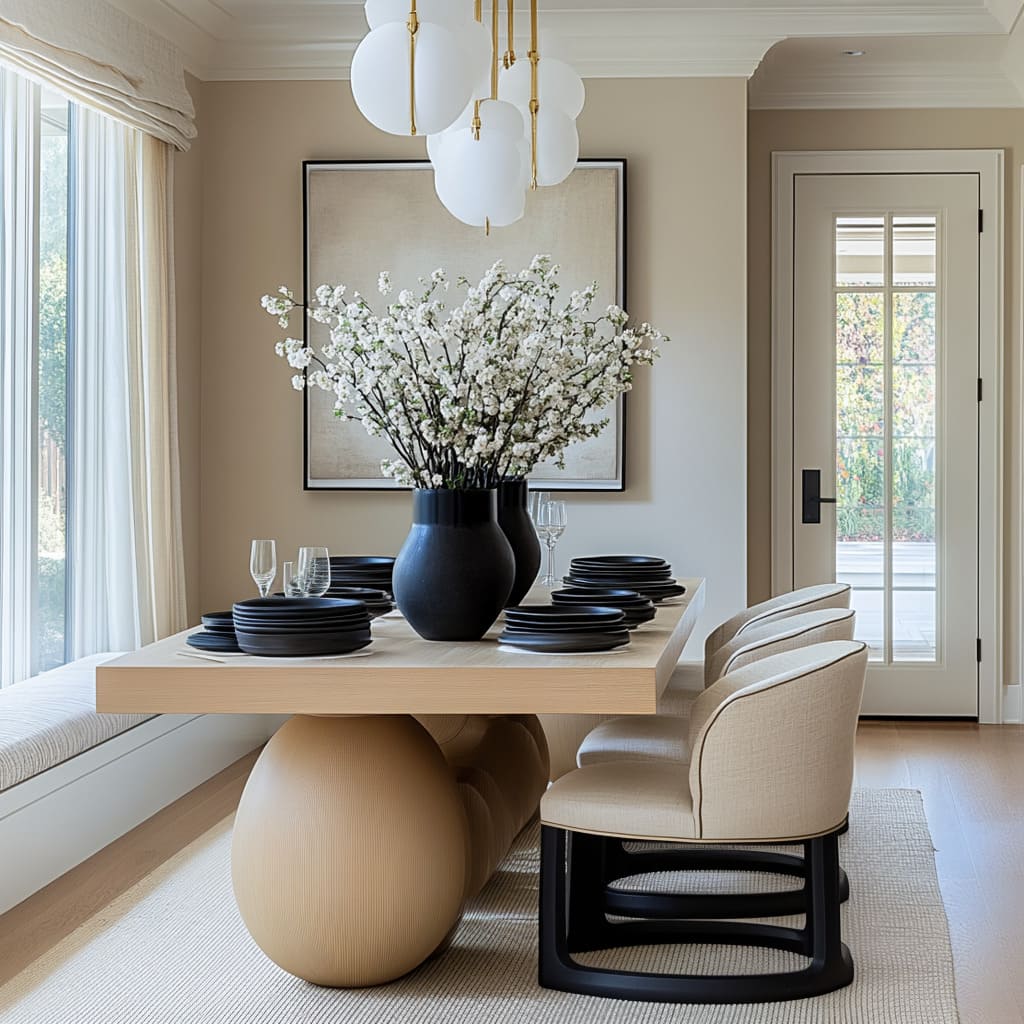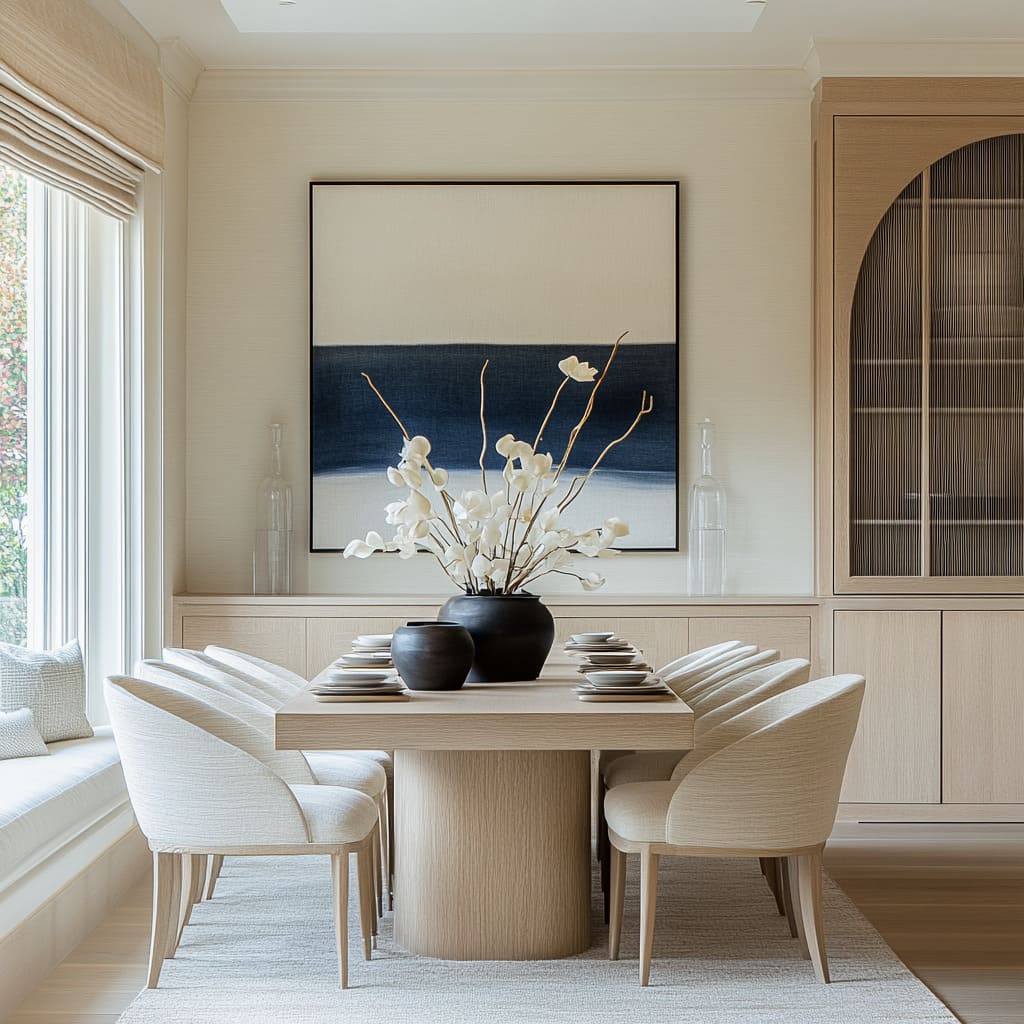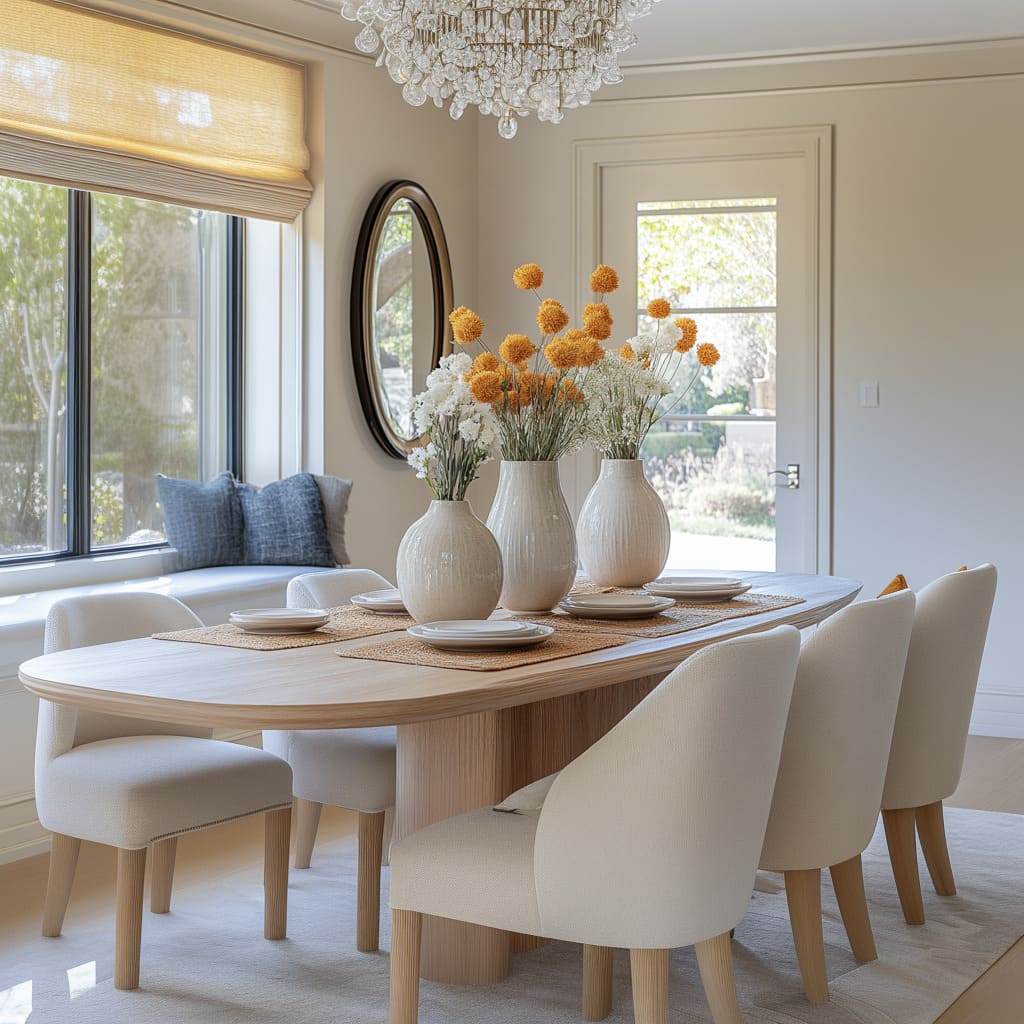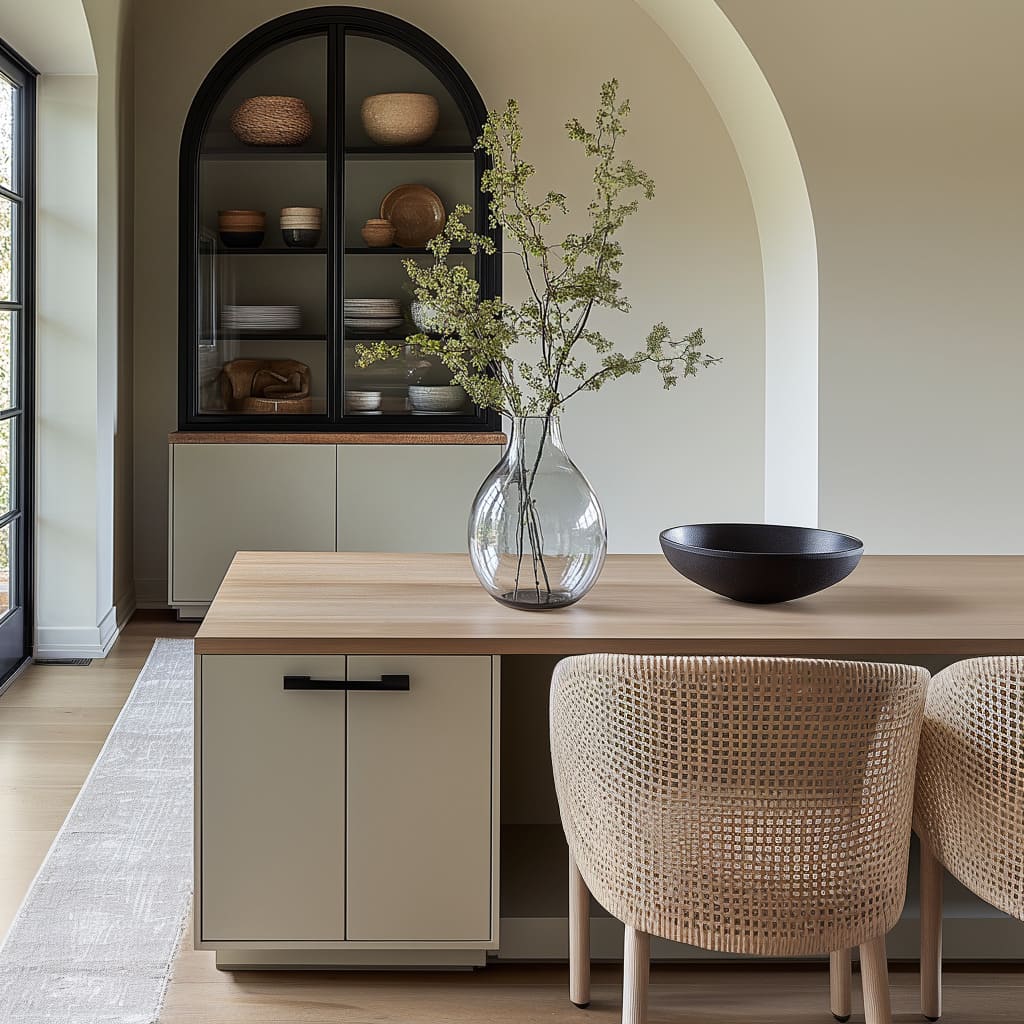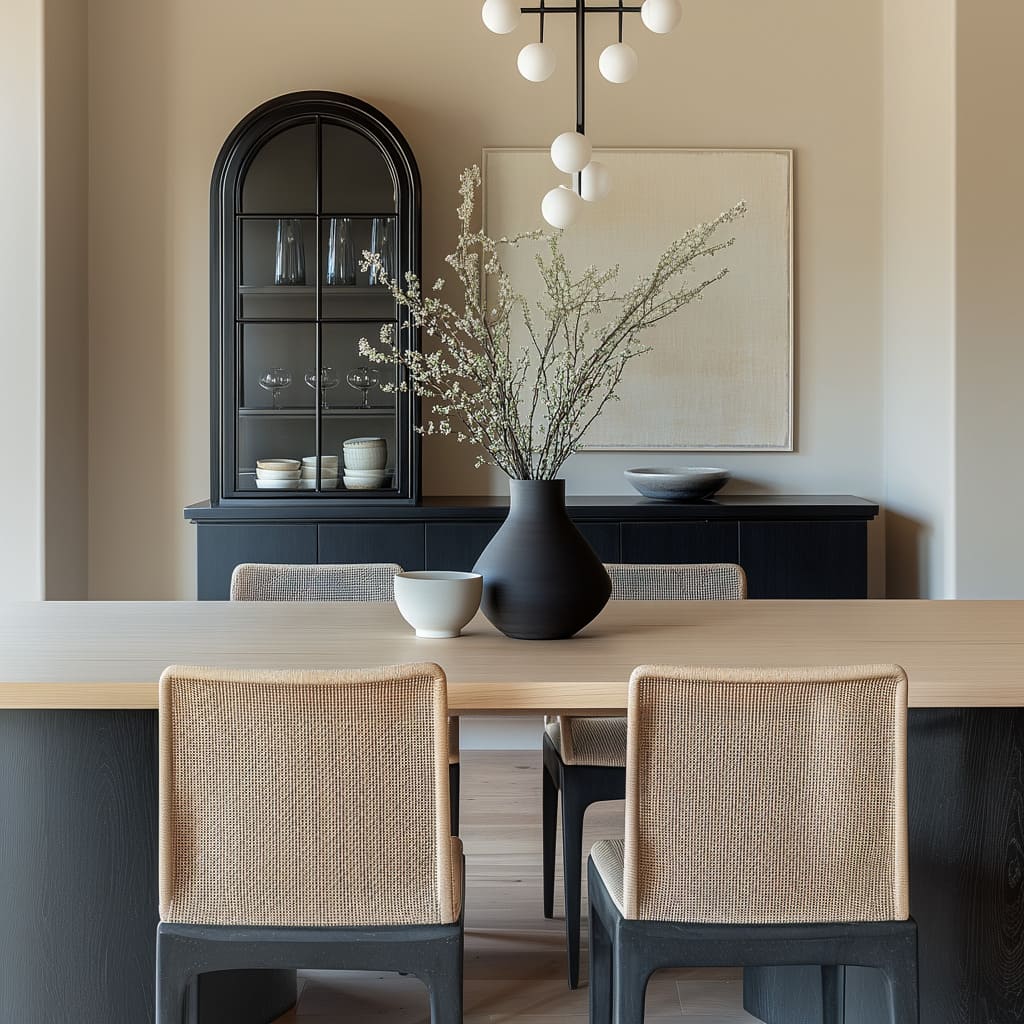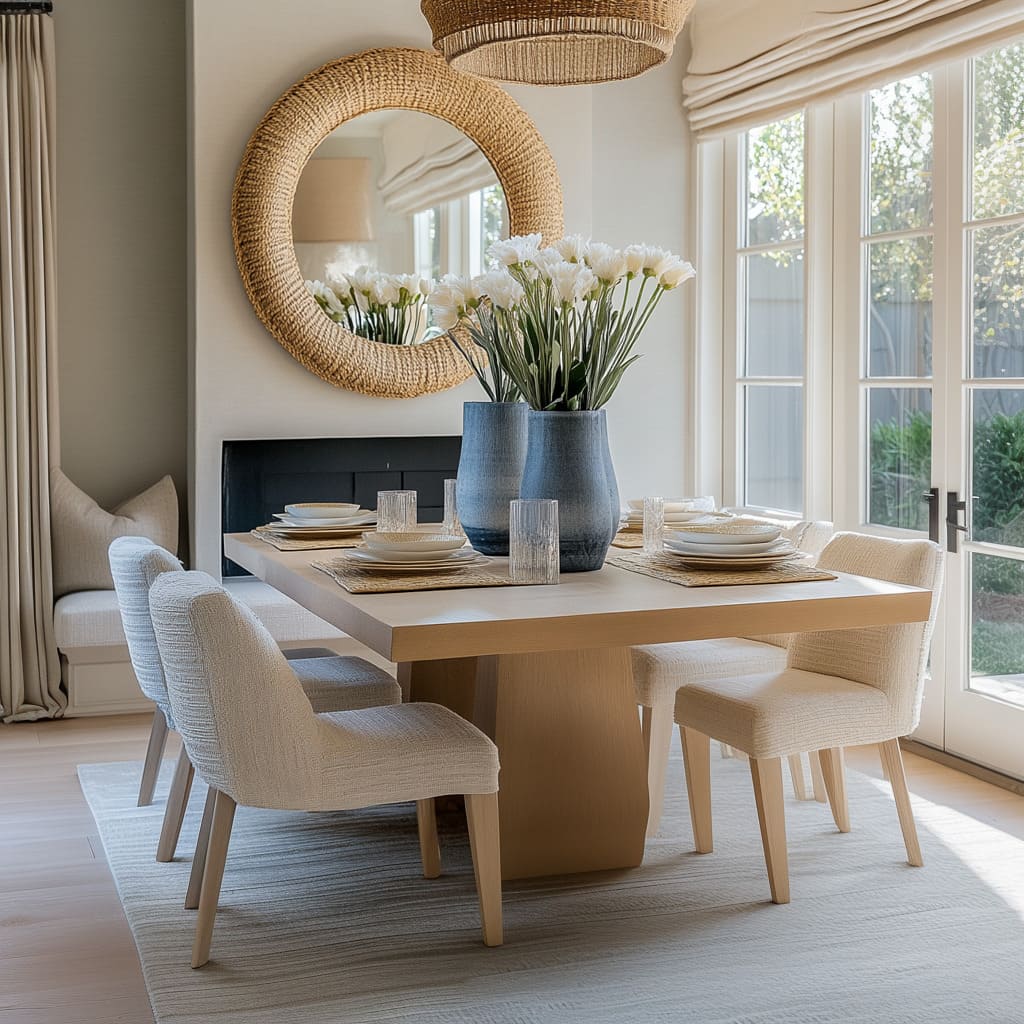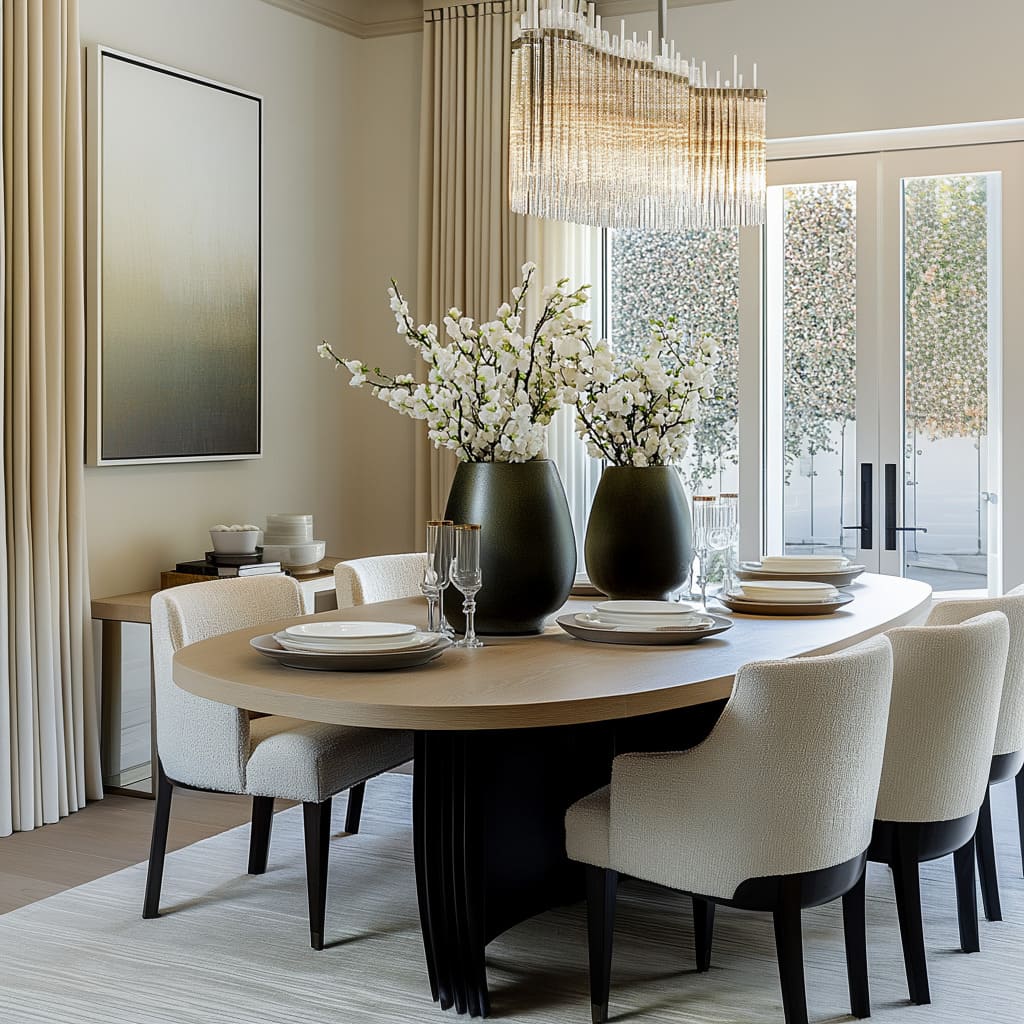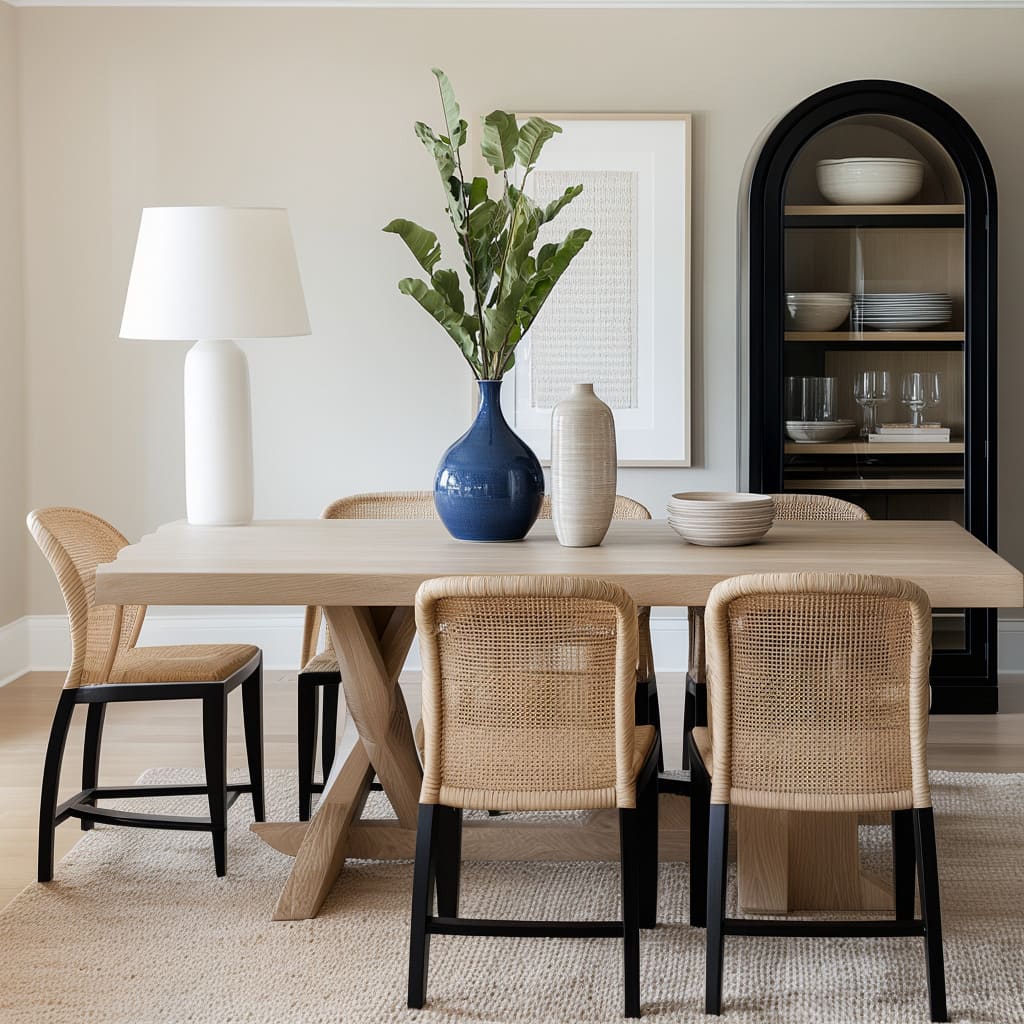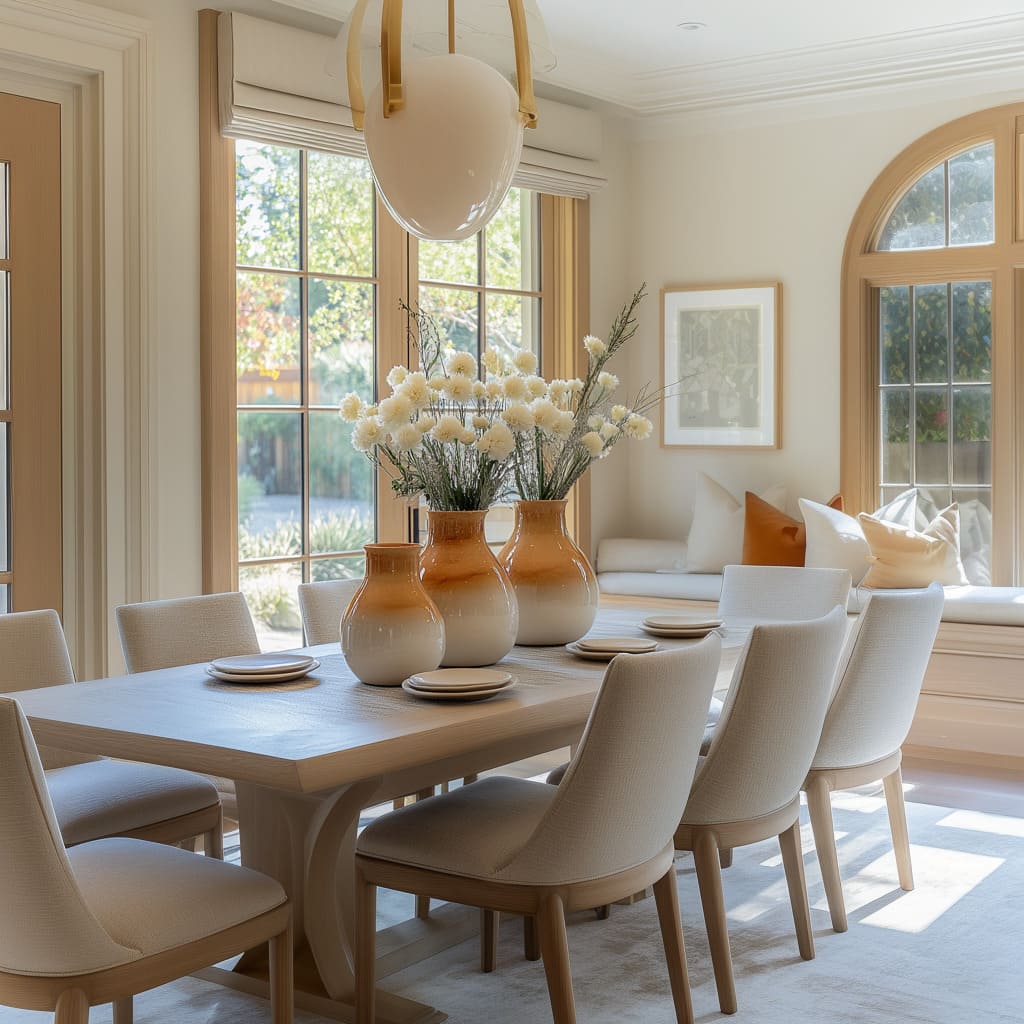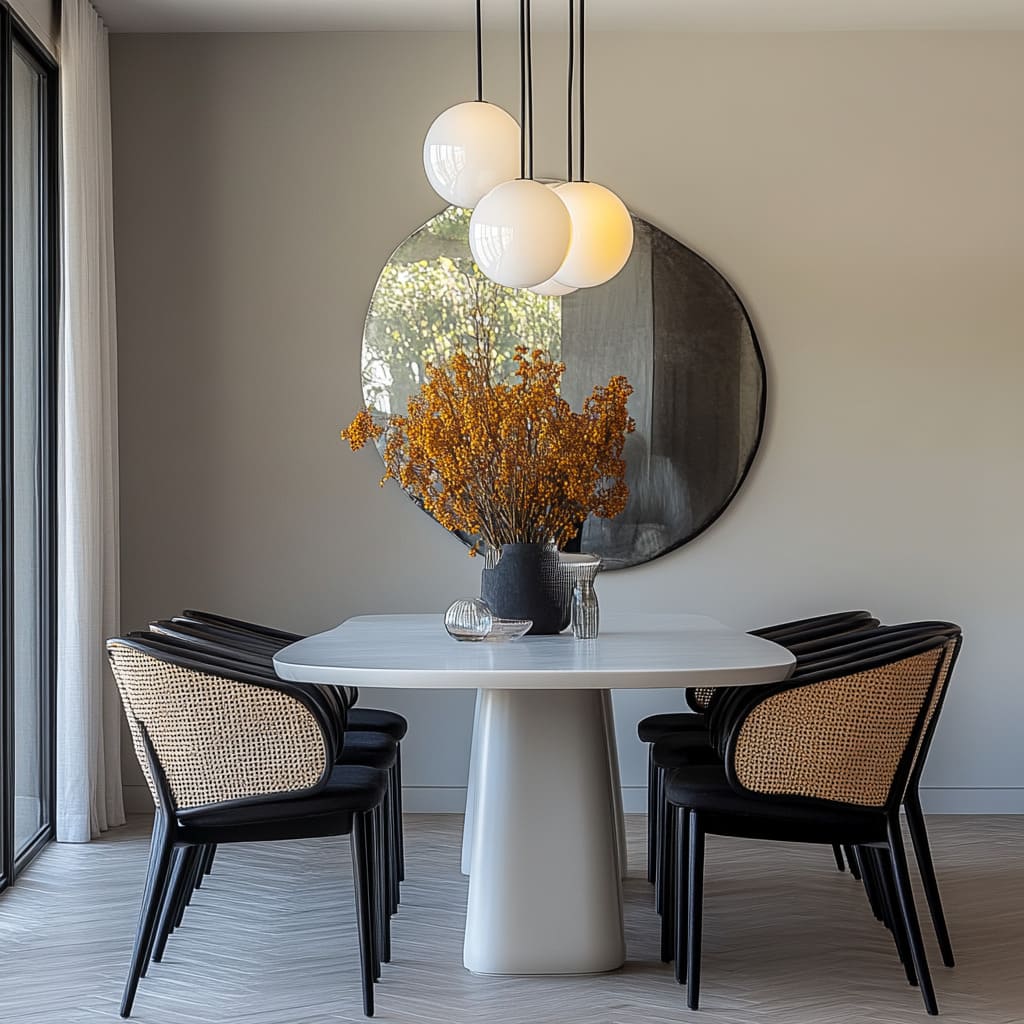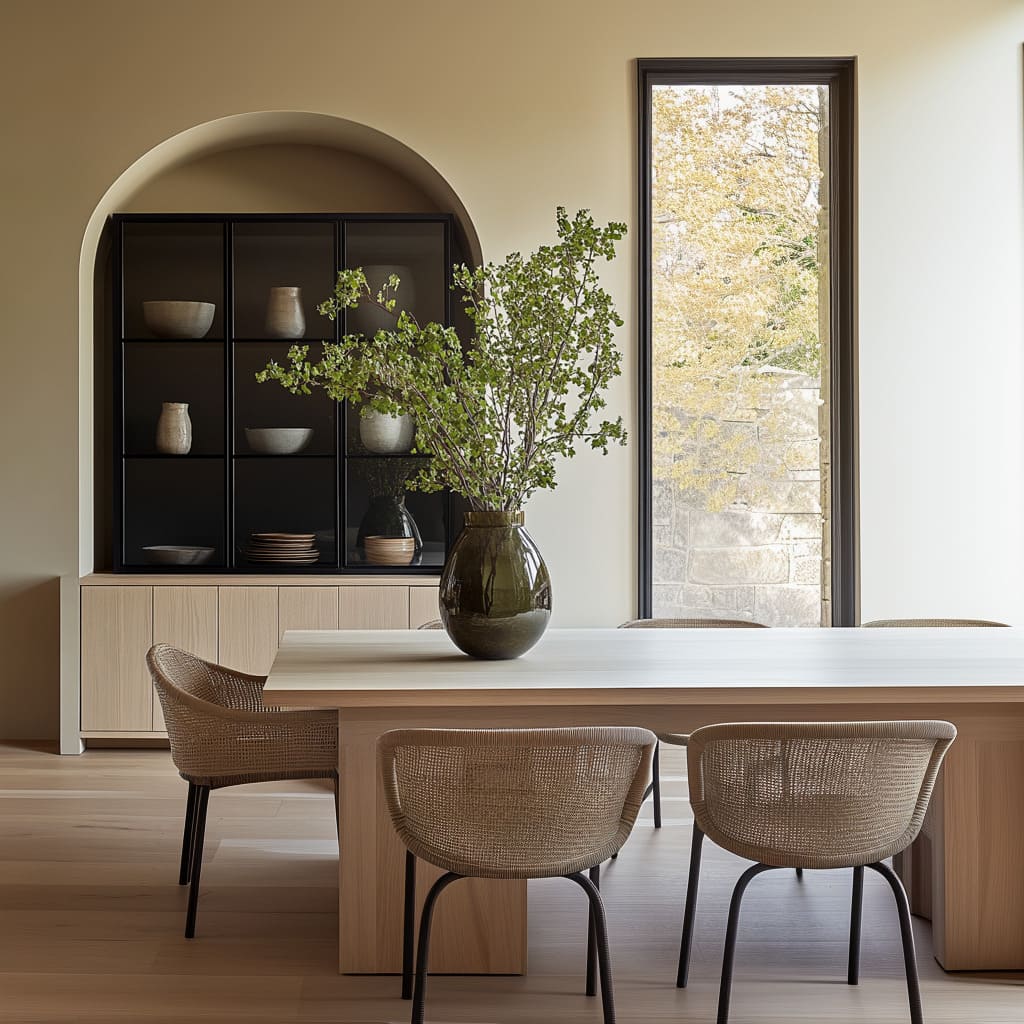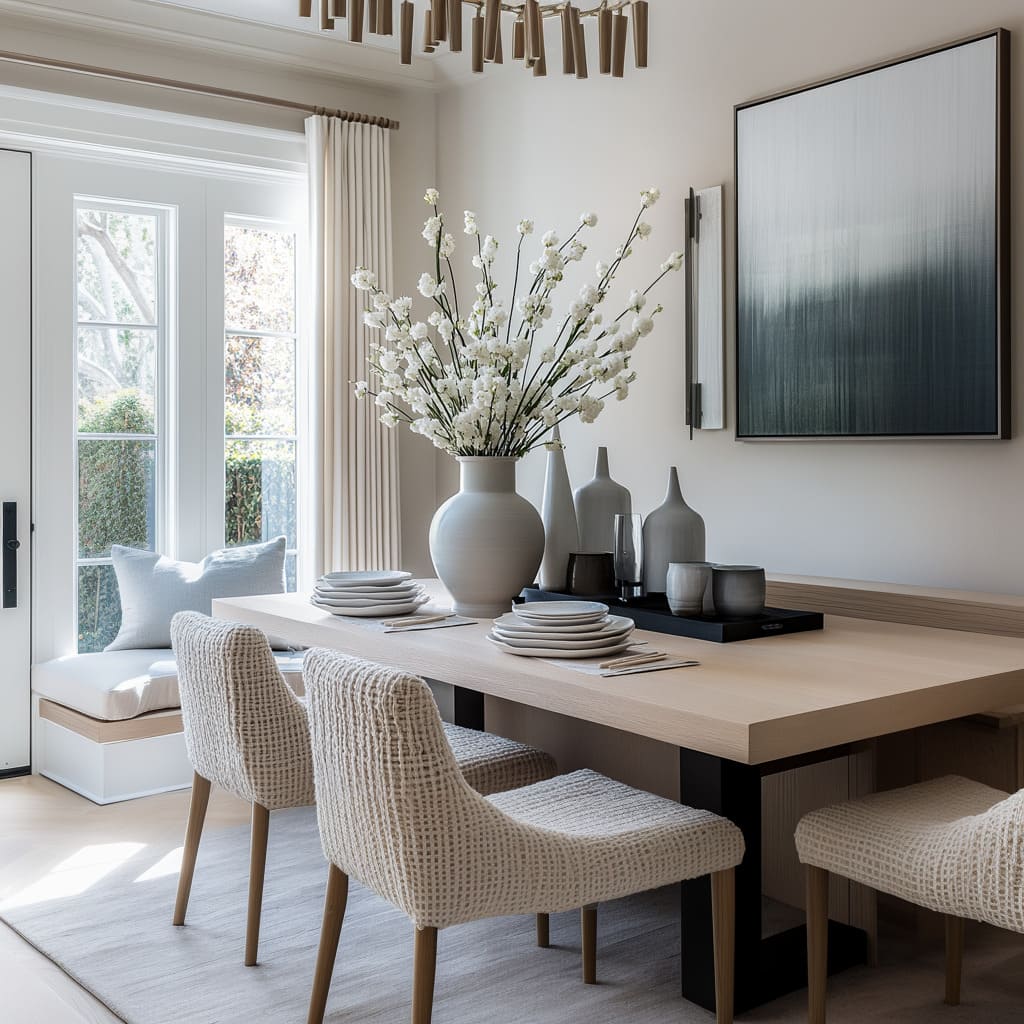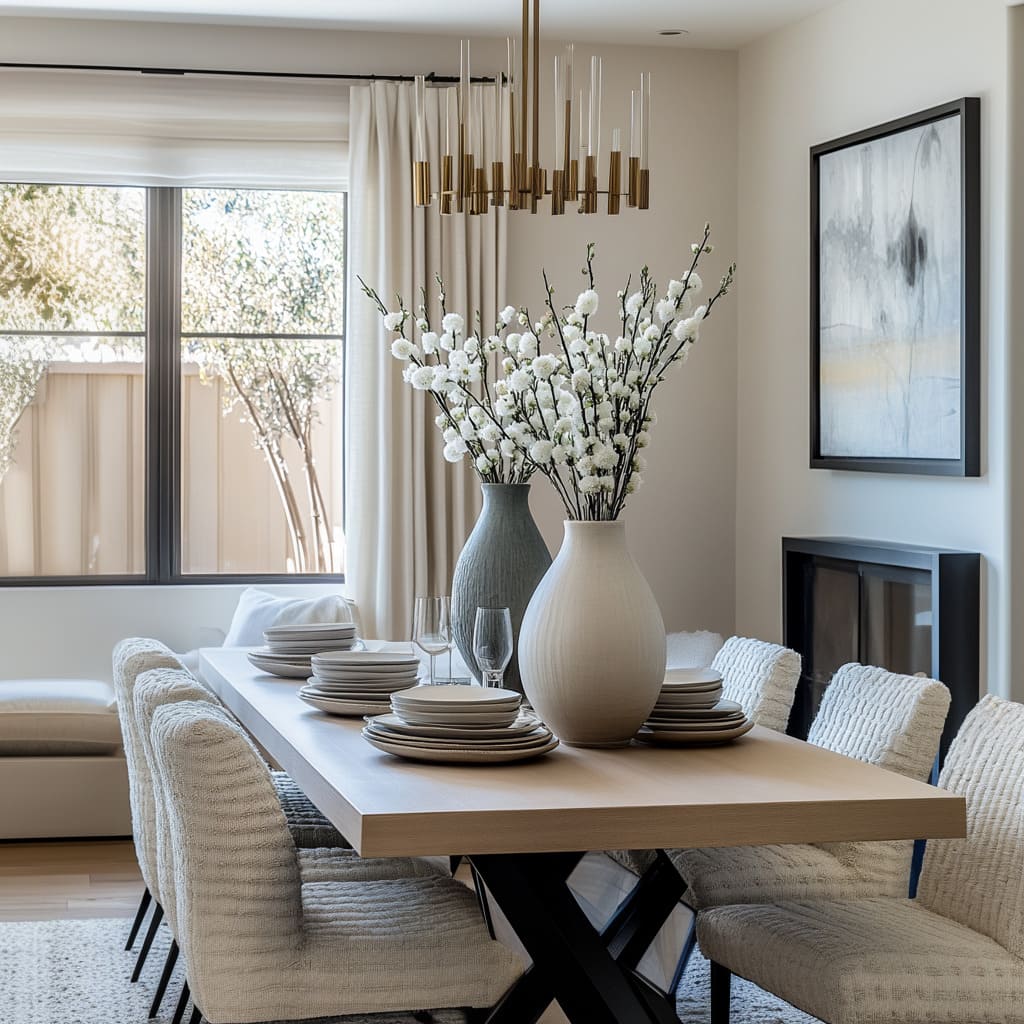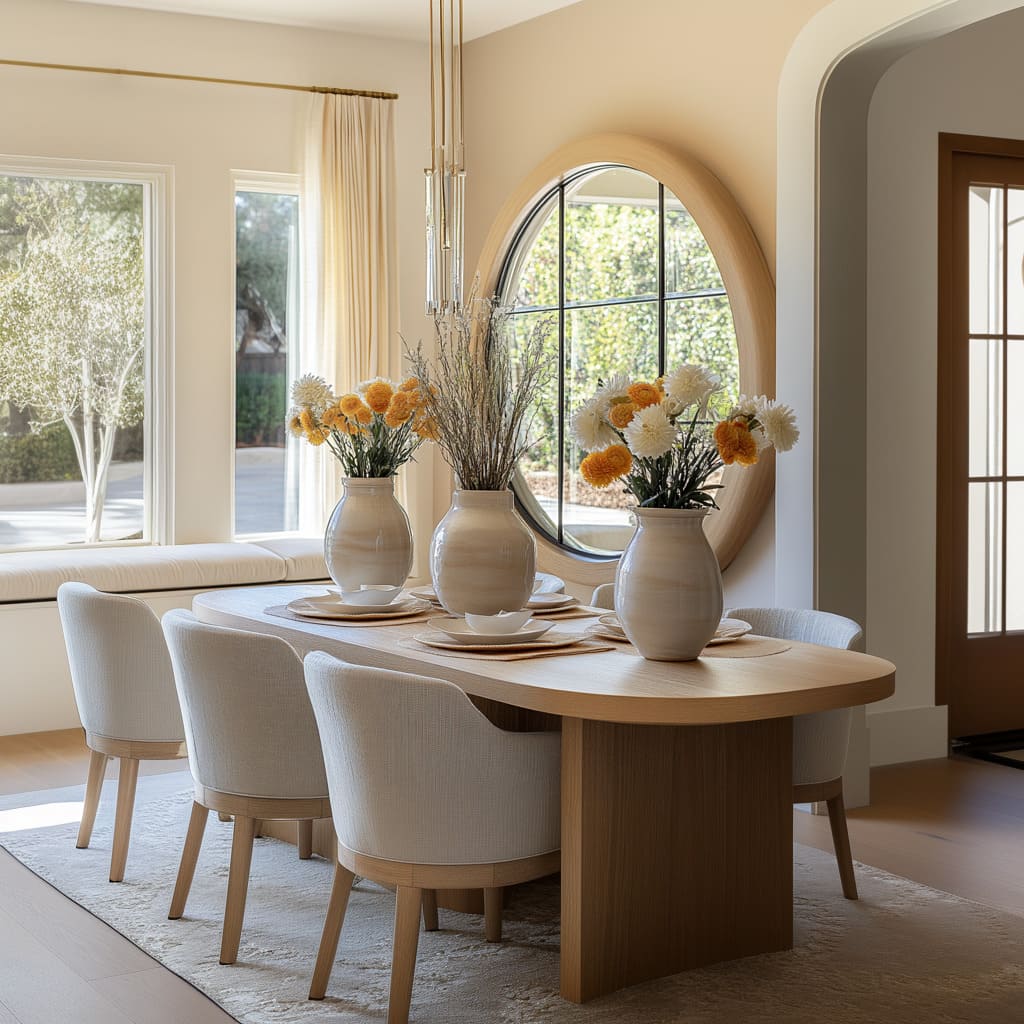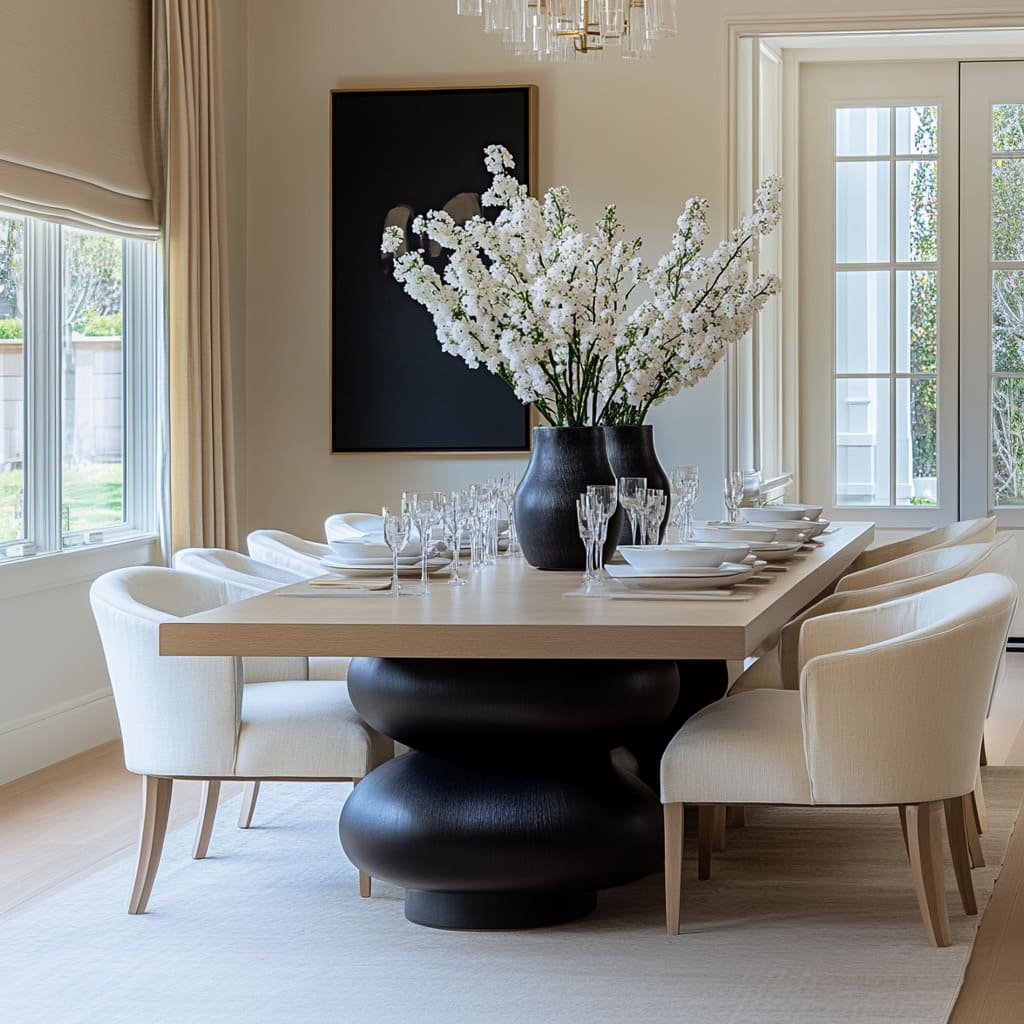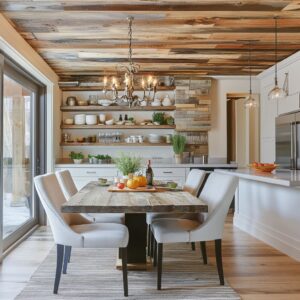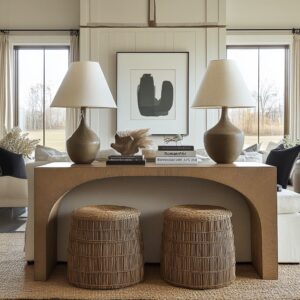The modern farmhouse style has redefined how we think about blending the charm of rustic living with sleek contemporary aesthetics. By thoughtfully combining natural materials, clean lines, and practical design elements, this style creates spaces that feel both welcoming and polished.
It’s no wonder that dining rooms are one of the most popular areas to adopt this trend—offering the perfect opportunity to showcase a harmonious balance of cozy and modern vibes. A dining room is more than just a place to eat; it’s the heart of family gatherings, celebrations, and everyday moments.
Whether it’s a quiet breakfast or a dinner party with friends, the atmosphere of this space sets the tone for connection and comfort. That’s why crafting a dining room that reflects warmth, functionality, and style is such an essential part of designing a home that feels complete.
This article explores inspiring modern farmhouse dining room ideas, offering tips and insights to help you transform your space into a haven of timeless appeal. From choosing the right furniture to incorporating decorative details, you’ll find practical suggestions for creating a dining room that is both visually stunning and deeply functional.
With a focus on combining natural textures and modern simplicity, these ideas will help you achieve a space that’s as versatile as it is beautiful.
The Perfect Farmhouse Dining Table: Finding Your Centerpiece
Choosing the right dining table is the cornerstone of crafting a modern farmhouse dining room. A well-selected farmhouse modern dining table becomes the visual and functional anchor of the space, bringing together rustic charm and contemporary appeal.
Wood is the material of choice here, offering a natural warmth and timeless quality. Light oak is a favorite for its bright and airy feel, while richer tones like warm walnut create a more grounded and intimate setting.
The tactile grain of the wood adds texture and depth, ensuring the table feels both authentic and inviting. When it comes to table styles, the options are as varied as the spaces they inhabit.
Rectangular tables are a classic choice, perfect for larger gatherings and narrow rooms. For smaller or more intimate spaces, round tables offer versatility and a softer aesthetic.
Oval designs strike a balance between the two, combining elegance with practicality. Pedestal bases are a popular modern twist, providing ample legroom and a sleek silhouette, while the traditional four-leg design evokes farmhouse heritage with understated strength and durability.
To add contrast and character, pairing natural wood with bold black bases can transform the look of your table. The juxtaposition of light wood tones against the richness of black creates a striking visual dynamic, ideal for those looking to add a contemporary edge to a farmhouse space.
This approach works particularly well in rooms with neutral palettes, allowing the table to become a focal point that effortlessly ties together other design elements. Styling your farmhouse dining table is all about keeping it simple yet impactful.
A single vase filled with seasonal greenery or fresh florals can make a big statement without overwhelming the table’s natural beauty. Choose a vessel that complements the style of your room—ceramics for a rustic touch, or glass for a cleaner, modern feel.
The greenery or flowers not only add life to the space but also help transition the table’s look throughout the year, keeping it fresh and personal.
Seating Options: Comfort Meets Style
Seating is where style and comfort come together to elevate the dining room experience. In a modern farmhouse setting, the choice of seating plays a crucial role in tying the entire space together while providing a welcoming atmosphere for long conversations over meals.
Rustic elegance is the foundation of farmhouse modern dining chairs, with designs that blend natural textures and warm tones. Woven cane chairs bring an artisanal touch, their intricate patterns adding depth and character to the room.
Rattan-backed chairs, often paired with neutral cushions, provide a relaxed yet refined look, while fully upholstered seating ensures both coziness and a polished finish. The interplay of textures creates a layered visual appeal, drawing the eye and inviting guests to sit back and stay awhile.
Incorporating mixed materials is an excellent way to infuse modern flair into a farmhouse-inspired dining room. Black metal frames paired with neutral-toned upholstery strike a perfect balance between the rustic and contemporary.
The metal accents add structure and boldness, while the fabric softens the overall aesthetic, creating a harmonious fusion. This combination works particularly well in dining spaces that aim to bridge casual charm with a touch of sophistication, making the seating an integral part of the room’s overall design.
Practicality doesn’t have to come at the expense of style. Upholstered benches or built-in window seating with cushions are both functional and visually appealing additions to a farmhouse dining room.
These options not only maximize seating capacity but also create a cozy nook for casual dining or quiet reading moments. Cushions in muted tones or subtle patterns can enhance the warmth of the space while providing an added layer of comfort.
For smaller spaces, these designs offer a smart way to optimize layout without crowding the room.
To keep the look fresh and engaging, consider mixing and matching seating styles. Pair upholstered chairs with woven benches, or combine cane-backed chairs with metal-framed options.
This approach adds a dynamic element to the design, making the dining area feel curated and personal. The key is to maintain cohesion by sticking to a consistent color palette or material theme, ensuring that the different styles work together seamlessly.
With thoughtfully chosen seating, your dining room becomes a versatile space that balances function and charm with ease.
Decorative Accents That Define the Space
The finishing touches in a dining room can transform it from functional to unforgettable. Decorative accents not only enhance the aesthetic appeal but also tie together the modern farmhouse style in thoughtful and practical ways.
When styling a dining table, start with a combination of materials that reflect the balance of rustic and contemporary. Ceramic bowls in soft, muted tones or textured finishes add depth, while glass vases provide a sleek contrast.
For a bolder touch, matte black accents—such as candleholders or small trays—bring a modern edge to the farmhouse vibe. Keeping the tabletop decor minimal ensures that the beauty of the dining table itself shines through while offering subtle visual interest.
The walls in a modern farmhouse dining room are a canvas for creativity and design. Large-scale abstract art in neutral or earthy tones introduces a contemporary flair, creating a striking focal point without overwhelming the room.
Minimalistic framed prints, often featuring natural or geometric motifs, provide an understated elegance that complements the clean lines of farmhouse interiors. A round mirror with a natural frame—such as rattan, oak, or distressed wood—can visually open up the space while reinforcing the rustic charm.
These thoughtful additions elevate the overall aesthetic, creating a harmonious blend of warmth and sophistication.
Functional storage is another element that seamlessly combines style and utility. Built-in cabinets or freestanding display units with black-framed glass doors are not only practical for organizing essentials but also serve as decorative features.
Use these spaces to showcase curated ceramics, wooden dishes, or woven baskets, embracing the earthy textures that define farmhouse decor. These accents add depth and personality, making the room feel more lived-in and inviting without sacrificing its polished appearance.
Lighting plays a pivotal role in setting the mood and highlighting the design of the space. Pendant lights are a staple in modern farmhouse dining room decorating ideas, offering versatility with finishes ranging from matte black to brushed brass.
Chandeliers, particularly those featuring a mix of metal and wood elements, add a touch of drama while staying true to the farmhouse aesthetic. Globe-style fixtures with soft, diffused light provide a contemporary twist, tying together the rustic and modern elements effortlessly.
By layering the right lighting choices, you can create a dining room that feels both cozy and refined, perfect for any occasion.
The Role of Natural Elements in Farmhouse Dining Rooms
Natural elements are a cornerstone of the farmhouse aesthetic, bringing warmth and authenticity to the dining space. Incorporating greenery is one of the most impactful ways to add vibrancy and a sense of life to the room.
Simple touches like a vase filled with leafy branches, potted plants, or a cluster of succulents can create a refreshing atmosphere. These natural accents work beautifully on dining tables, sideboards, or even window sills, complementing the earthy textures found in farmhouse decor.
Seasonal greenery offers a dynamic element, allowing the decor to evolve subtly throughout the year while keeping the space fresh and engaging.
Maximizing natural light is essential in achieving a bright and inviting modern farm dining room. Large windows or French doors are perfect for creating an airy ambiance, flooding the room with light and visually expanding the space.
Minimalistic window treatments, such as sheer linen curtains or neutral Roman shades, ensure privacy without compromising the flow of light. These simple solutions enhance the organic feel of the space, connecting the interior to the outdoors and making the room feel more in tune with nature.
Light streaming in through unobstructed windows also highlights the texture and grain of wood furniture, emphasizing the rustic elements of the design.
Flooring choices play a significant role in grounding the overall design of a farmhouse dining room. Warm wood flooring, whether in natural oak or distressed finishes, provides the perfect foundation for this style.
The rich tones and subtle imperfections of wood flooring contribute to the relaxed and welcoming feel characteristic of farmhouse spaces. To add further texture and comfort, natural fiber rugs like jute or sisal can be layered beneath the dining table.
These rugs complement the wood while introducing another layer of tactile appeal, tying together the modern and rustic influences seamlessly. By incorporating greenery, maximizing natural light, and choosing thoughtful flooring materials, you can create a dining room that feels connected to nature while retaining its stylish edge.
The interplay of these natural elements with the modern farmhouse design ensures a balanced space that is as functional as it is beautiful, making it ideal for family meals and gatherings alike.
Creating a Balanced Color Palette
The color palette is the backbone of any well-designed dining space, and in the context of a modern cottage dining room, it plays a crucial role in establishing the cozy yet refined aesthetic. Neutral shades like beige, cream, and gray provide a soft foundation, allowing the room to feel light and welcoming.
These hues serve as a versatile backdrop, making it easy to layer in additional textures and colors without overwhelming the space. From the walls to the upholstery on dining chairs, these muted tones create an atmosphere of understated warmth, ensuring the room feels both cohesive and comfortable.
Introducing accent tones is key to adding depth and interest. Contrasting shades like black, olive green, and navy can be incorporated through furniture pieces, light fixtures, or even decorative objects.
For instance, a black-framed cabinet or navy cushions on window seating can provide a bold counterpoint to the neutral backdrop. Olive green, when used subtly in decor items like vases or plants, brings a natural and earthy touch that complements the farmhouse style beautifully.
These darker accents ensure the space feels dynamic and layered, balancing simplicity with character.
Textures bring life to a color palette, making the design more engaging and tactile. Smooth wooden dining tables, woven cane chairs, and matte finishes on light fixtures all contribute to a well-rounded look.
A rug made from natural fibers like jute can ground the dining area, while soft linen curtains introduce another layer of texture. Combining different materials not only keeps the space visually interesting but also reflects the charm of a farmhouse aesthetic with a contemporary twist.
The interplay of these textures ties the room together, ensuring every element feels intentional. Achieving the right balance in color and texture is essential for a dining room that feels cohesive and inviting.
The neutral foundation anchors the space, while thoughtful accents and dynamic textures bring personality and depth. This approach ensures that your modern cottage dining room is not only visually appealing but also a space where everyone feels at home, whether enjoying a quiet dinner or entertaining guests.
Layout and Space Planning for Style and Functionality
A well-thought-out layout is essential for creating a dining room that feels both stylish and functional. When designing the layout, start by aligning the size of the dining table and chairs to the proportions of the room.
A large table in a compact space can overwhelm, while an undersized table in a spacious room can leave the area feeling sparse. For a balanced look, ensure there’s ample clearance around the table for movement while maintaining a cozy seating arrangement.
Proportionality not only enhances visual harmony but also ensures comfort for everyday use and gatherings. The choice between open and defined dining spaces often depends on the overall flow of your home.
Open-plan layouts are perfect for fostering a sense of connection, especially in homes that combine the kitchen, dining, and living areas into one expansive space. In these setups, using a rug or strategically placed furniture can subtly define the dining area while keeping the openness intact.
On the other hand, enclosed dining rooms provide an opportunity to create a more intimate atmosphere. In both scenarios, adding elements like a statement chandelier or wall-mounted art can anchor the dining room as its own focal point.
Seating arrangements are crucial for accommodating different needs, whether it’s a casual dinner or a festive gathering. For small families or intimate meals, standard chair configurations around a rectangular or round table often suffice.
Larger dinner parties benefit from flexible seating options like benches, which can accommodate more people without crowding the space. Additionally, upholstered window seating or built-in banquettes can serve as multi-functional elements, blending comfort with practicality.
These options work seamlessly with farmhouse aesthetics, offering a blend of charm and utility. When planning the layout, remember that the dining room should reflect both your style and functional needs.
Balancing open areas with thoughtful furniture placement ensures that the space feels inviting yet structured. Incorporating these principles can bring your country style dining room decorating ideas to life, creating an environment that’s equally suited to quiet meals and lively celebrations.
Combining Traditional and Contemporary Styles
A dining room that seamlessly merges traditional and contemporary styles can stand out with a character that feels both unique and welcoming. By thoughtfully mixing eras, you can create a space that honors timeless design while embracing fresh, modern aesthetics.
For instance, consider pairing vintage-inspired elements like arched cabinets or display units with sleek, minimalistic dining tables and chairs. The juxtaposition of these styles can create a visually intriguing balance, with the charm of the past blending effortlessly into the clean lines of today.
Classic farmhouse staples, such as rustic wooden furniture or woven accents, can be elevated with subtle modern updates. Imagine a dining table featuring a rough-hewn wood top contrasted with a bold, black base for added sophistication.
Similarly, rattan or cane-backed chairs can be framed with modern metal or painted wood to give them a fresh twist. These combinations not only enhance the visual appeal of your dining room but also make it feel versatile and thoughtfully curated.
What makes this blend so appealing is its ability to remain current while maintaining a sense of tradition. The careful use of neutral tones and natural textures ensures the space feels grounded, while modern finishes, like matte black or brushed metal, add a contemporary edge.
This approach works particularly well in dining rooms designed to adapt to different occasions, balancing casual comfort with formal elegance. By thoughtfully blending the old with the new, you can unlock countless farmhouse decorating ideas for dining room setups.
This design philosophy not only enhances the aesthetic appeal of your space but also ensures it remains timeless and relevant for years to come. Whether it’s through bold contrasts or subtle nods to tradition, the combination of these styles can help you achieve a dining room that’s as inviting as it is stylish.
Practical Storage and Functionality
Storage solutions are a crucial aspect of designing a dining room that is as functional as it is stylish. Built-in cabinets offer a seamless way to integrate storage into the space while maintaining a polished and uncluttered look.
These recessed features not only save space but also create opportunities for design accents, such as glass-front panels or decorative hardware. In a farmhouse dining room, built-in cabinetry painted in warm neutrals or soft whites can blend effortlessly with the overall decor, serving as the perfect place to display curated dinnerware, glassware, or decorative items.
Freestanding furniture is another practical yet stylish option. Arched black display units, for example, can add a dramatic touch while providing ample storage.
The curved design adds a hint of vintage elegance, while the dark frame ensures a modern edge. These units are versatile, working equally well as a focal point or a complementary piece in the dining area.
Use them to showcase ceramics, woven baskets, or even potted greenery, aligning with the farmhouse aesthetic. Their open shelving and enclosed sections make it easy to combine practicality with artistic display.
Dual-purpose features are particularly valuable in farmhouse formal dining room ideas, where functionality and style must work hand in hand. Buffets and sideboards are excellent additions, offering storage for linens, flatware, and serving dishes while doubling as decor platforms.
A wooden sideboard with a distressed finish can reinforce the rustic charm, while modern decor elements like black ceramic vases or abstract art on top keep the look updated. For added utility, consider sideboards with hidden compartments or adjustable shelves, ensuring they meet both aesthetic and practical needs.
By thoughtfully incorporating built-in cabinetry, freestanding furniture, and dual-purpose pieces, you can create a dining room that not only looks beautiful but also functions seamlessly. These storage solutions strike the perfect balance between form and utility, making your farmhouse dining room an inviting and organized space for everyday use and special occasions alike.
Adding Warmth with Personal Touches
Infusing warmth and character into a dining room often comes down to the smallest details. Seasonal updates are a simple yet impactful way to keep the space feeling fresh and inviting throughout the year.
Swapping out vases and floral arrangements to reflect seasonal themes—such as bright blossoms in spring, sunflowers in summer, or pine branches in winter—can transform the atmosphere without requiring a full redesign. These subtle changes not only refresh the decor but also bring an organic, lived-in feel that aligns perfectly with a minimalist farmhouse dining room.
Personal touches are another essential element of creating a truly welcoming space. Incorporating meaningful decor pieces, such as family heirlooms, framed photographs, or handmade items, adds layers of personality.
A vintage clock on the wall or a cherished serving dish displayed on a sideboard can become conversation starters while grounding the room in its unique history. This approach ensures the dining room is not just visually appealing but also deeply personal, fostering a sense of connection for everyone who gathers there.
Layering textures is key to enhancing the warmth and coziness of a farmhouse dining room. Soft throw cushions on a built-in bench or dining chairs can make seating more comfortable while introducing pops of color or subtle patterns.
Rugs placed under the dining table, especially those made of natural fibers like jute or wool, add softness and define the space. Draped linen curtains or woven table runners can further enhance the texture, creating a cohesive and inviting ambiance that balances the rustic and modern elements of the room.
By incorporating seasonal decor, meaningful personal items, and layered textures, your dining room will feel not only stylish but also uniquely yours. These thoughtful touches bring together the charm and functionality of a minimalist farmhouse dining room, making it a space where memories are made and cherished for years to come.
Conclusion
A stylish farmhouse dining room combines warm materials, functional layouts, and a thoughtful balance of rustic charm with modern design elements. From selecting the perfect dining table and seating to incorporating natural elements and carefully chosen decor, each detail plays a role in creating a space that feels both inviting and sophisticated.
These farmhouse dining room ideas offer a foundation, but the true magic happens when you add your unique preferences. Whether it’s through bold accent choices, seasonal decor updates, or heirloom pieces, the key is to maintain harmony while reflecting your personality.
With the right balance, your dining room becomes more than just a place to eat—it becomes a space where memories are made and shared for years to come.

